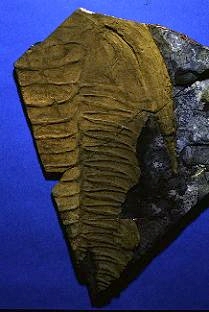
| Case study 2 - Distribution of trilobite tubercles |
Data file: paradox.dat
The file contains the digitized coordinates of 136 tubercles from a cranidium of the Middle Cambrian trilobite Paradoxides forchhammeri (see Hammer 2000).
 |
Paradoxides forchhammeri (Paleontological Museum, Oslo). Length approx. 25 cm. |
What can we say about the distribution of these tubercles? Are they apparently randomly spaced, or are they clustered or overdispersed?
Open the file Paradox.dat. Select the two first columns (by clicking on the 'X' label and then shift-clicking on the 'Y' label). Choose 'XY plot' in the 'Plot' menu. Select 'Points' as the plot style. Do the tubercles seem evenly spaced?
Now choose 'Points' in the 'Geomet' menu. You should get the following results:

The program tests the tubercle pattern against patterns produced by a so-called Poisson process. In a Poisson process, points are added sequentially, in a random fashion, without regard for the points already present. The probability of a Poisson process being responsible for the tubercle pattern is minute, so this hypothesis can be rejected. To get further information, look at the value of R. Being larger than 1, it indicates that the points are overdispersed, meaning that they seem to 'avoid' each other.
One explanation for this could be that tubercles are positioned with the help of a lateral inhibition mechanism. Such a mechanism has been shown to be responsible for similar spacing patterns in the sensory bristles of insects.
More information about the point distribution module can be found in the manual.